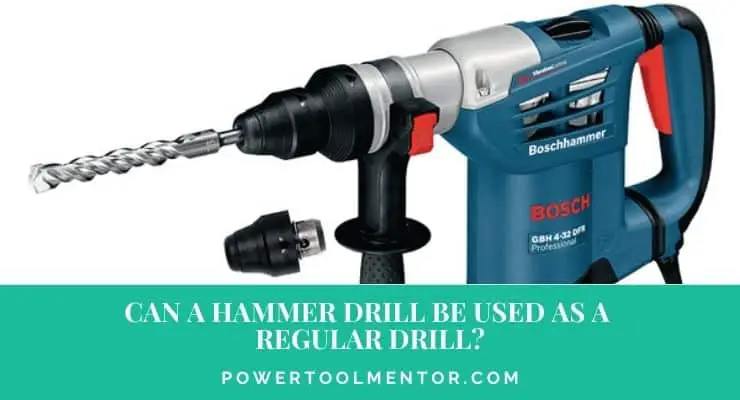We’re all looking to save on space and cut on costs that come with having several tools, and hammer drills can help you achieve that. You can use a hammer drill as a regular drill when you attach the right additional tools like drill bits and screws.
Can a hammer drill be used as a regular drill?
What exactly is a hammer drill
A hammer drill is a special kind of power tool that is used for drilling holes into tough material surfaces like rocks, bricks, masonry, and concrete. It uses a rotational force and a forward-thrusting action to create a more powerful pounding force making it spin and hammer at the same time. This causes it to vibrate from the front to the back allowing it to penetrate and dig deeper through hard materials. This is something a regular drill can’t handle.
What are the differences between a regular drill and a hammer drill?
Design and build
Both a regular and hammer drill has drill settings as well as clutch settings for versatility and stability respectively. In most cases, a manufacturer will start with a regular drill and then add the hammer drill functionality to it. This makes the power tool longer and heavier to handle the applications it’s designed for. The main difference is that a hammer drill comes with a hammer mode that you can toggle to access either the regular drill or the hammer drill depending on what task you want to tackle.
Performance and mechanism
Both types of drills are meant for drilling and driving screws into materials. The difference lies in their speed, torque, and the quality of the material it can be used on. A regular drill comes with lower speeds and torque that is enough to handle light to medium tasks. It can be used on wood, drywall to mount painting and curtains, and on light-duty metals. It can’t however be used on heavy-duty materials like masonry. This is where a hammer drill comes in. Besides doing what a regular drill does, a hammer drill can penetrate through heavier materials like bricks, stone walls, masonry, heavy-duty metal, and concrete.
All you need to do is choose the right drilling mode for the right job. If you’re doing a regular drilling task, then switch on the drilling mode, and for heavy-duty applications, switch on the hammer mode.
On the mechanism, a regular drill makes use of continuous rotational force to penetrate or drive a screw into a material surface. A hammer drill on the other hand uses a rotational force as well, but it creates a more powerful pounding/hammering force that enables it to drive the screw faster straight down.
Do I need both a regular and hammer drill?
This is a good question especially for someone looking to buy a drill for the first time. You don’t need both power machines when a hammer drill can serve as both. All hammer drills come with a switch that you can use to toggle between the two drilling modes. This is a simple button that you need to press and engage the hammer action. However, most people with a hammer drill don’t use them as a regular drill because of their heavyweight compared to these regular drills.
Alternatives to a hammer drill
There are alternative tools that you can use to perform similar tasks to a hammer drill. They include a rotary hammer, a demolition hammer, and a combination hammer. Rotary hammers use rotation and hammering action to break up concrete when the drill bits rotate and are designed for daily use. On the other hand, demolition hammers are also heavy-duty power tools but designed to break up or chip concrete. Finally, Combination hammers are dual-mode hammers that can do what both the rotary hammer and demolition hammer can do.
The merits and demerits of using a hammer drill as a regular drill
| Merits | Demerits |
| It offers more power | It’s heavier and larger |
| It’s versatile | Not ideal for woodworking |
| It’s more expensive |
Frequently Asked Questions (FAQs)
Can I use a regular drill for drilling into concrete?
While it’s not completely impossible to drill into the concrete using a regular drill, it’s recommended that you use a hammer drill for drilling into concrete. This is because a hammer drill is specially designed to perform such a task. You may end up spoiling your regular drill if you used it instead.
What chuck size does a hammer drill use?
A hammer drill uses chuck sizes similar to regular drills. It uses ¼ – inch, ½ – inch, or the ⅜ – inch chuck size to hold drill bits and screws in place.
Conclusion
Though hammer drills can be used as regular drills using the right switch, they are heavy. Apart from being able to penetrate through hard materials like concrete and masonry, hammer drills don’t add any value to a regular drill’s functionality. Regular drills are more suited in handling their role than hammer drills. However, you can buy a hammer drill as still use it as a regular drill to save on costs and space.
